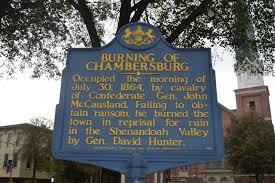The Burning of Chambersburg Historical Marker
Introduction
Text-to-speech Audio
Images
This historic marker is just outside the county courthouse and one of several markers dedicated to the destruction of the town during the Civil War.

Backstory and Context
Text-to-speech Audio
On the morning of July 30, 1864, under the orders of General Jubal Early, General John "Tiger" McCausland seized Chambersburg and demanded $100,000 in gold or $500,000 in US currency. According to Confederate leaders, this attack was retribution for the burning of rebel property by the United States Army in Virginia.
The Federal commander General Hunter, under orders from General Grant, was instructed to destroy provisions in the Valley of Virginia. He was also instructed not to destroy private homes. General Hunter ignored this caveat and destroyed many private dwellings, including those that were inhabited by women with children. Hundreds of families lost their homes, livestock, fields and personal possessions in an era when few families had insurance.
General Early, in his autobiography, wrote that he "came to the conclusion it was time to open the eyes of the people of the North to this enormity, by an example in the way of retaliation." Early chose McCausland for this task, as his brigade of cavalry was comprised primarily of soldiers hailing from southwestern Virginia. Many of these men and their families were directly affected by Hunter's vicious attacks in Virginia, and they wanted revenge.
The goal of the campaign was to raise funds, enact suffering upon southern Pennsylvania, and take control of the Cumberland Valley Railroad. If successful, Confederate leaders believed that these raids would and divert Union troops from the attacks on Confederate positions in eastern Virginia.
Historians still debate whether the citizens of Chambersburg considered paying the ransom. Many may have hoped for deliverance from their occupiers as a large army under the command of General Averell. The army was a short distance away in Greencastle, and the citizens might have stalled the Confederate army by offering a partial payment. Whatever the reason, city leaders refused to pay the ransom or promise to raise the funds. Prior to executing their orders, Confederate troops made sure that every resident was given the opportunity to exit a building or home prior to setting it aflame. A total of five hundred buildings were destroyed by Confederate forces, with only churches and a Masonic temple being spared.
